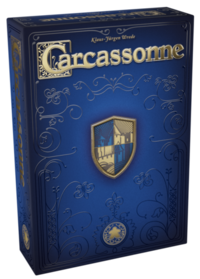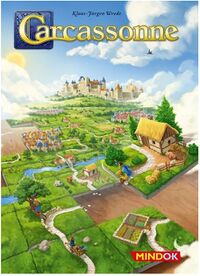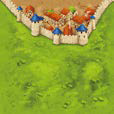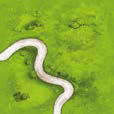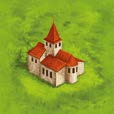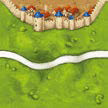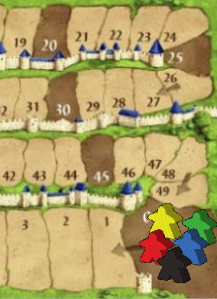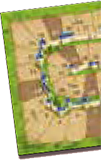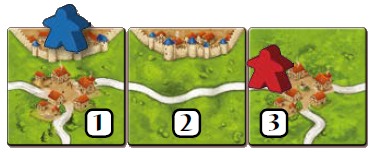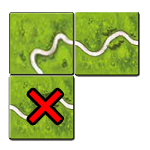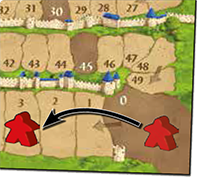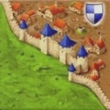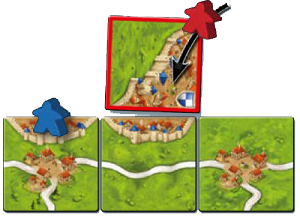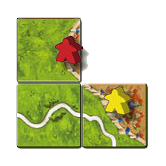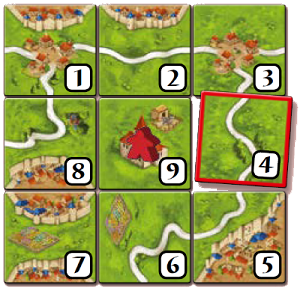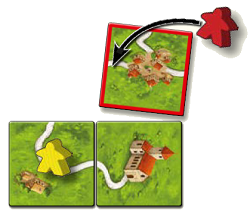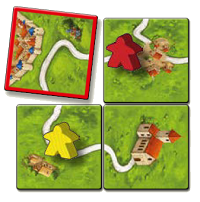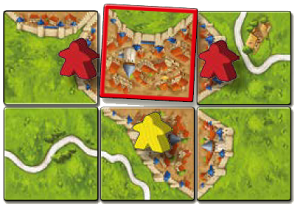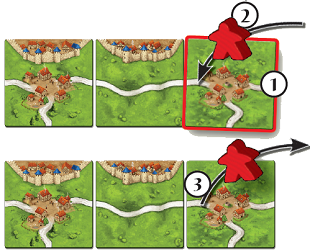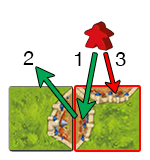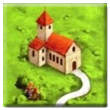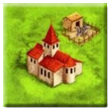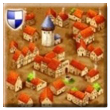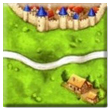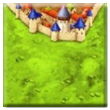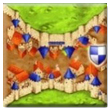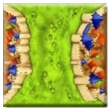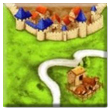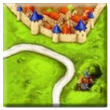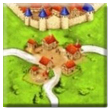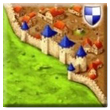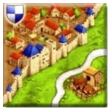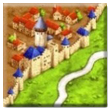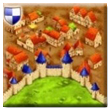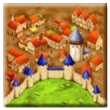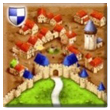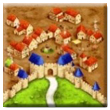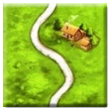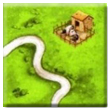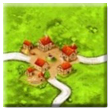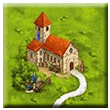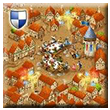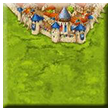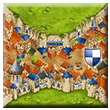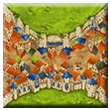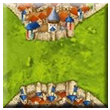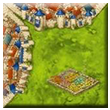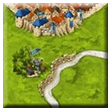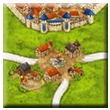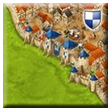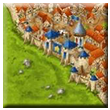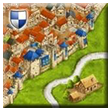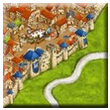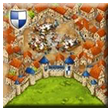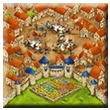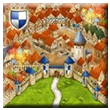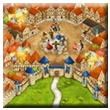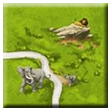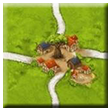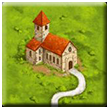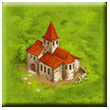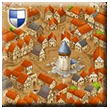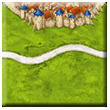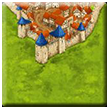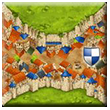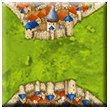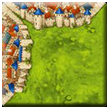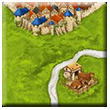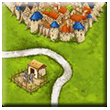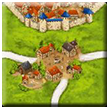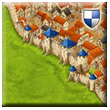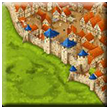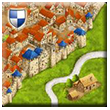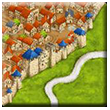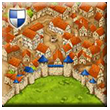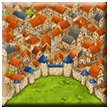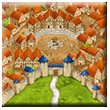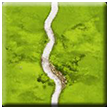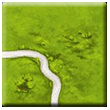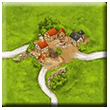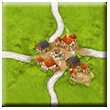Základná hra Carcassonne
| [[File:{{{image}}}|x75px|class=notpageimage|link=]] | Čítate pravidlá k takto ilustrovaným kartičkám. |
 | Ak sa vaše kartičky podobajú týmto, prejdite na nasledujúce pravidlá: |
| Majú vaše kartičky úplne iný dizajn? Potom si vyberte z hier rodiny Carcassonne. |  |
Hlavná stránka > Carcassonne > Základná hra Carcassonne
Úvod
Juhofrancúzke mesto Carcassonne je povestné svojím jedinečným opevnením, ktoré sa vyvíjalo od rímskych dôb až do veky rytierov. Hráči so svojimi spoločníkmi vyrážajú na cestu, lúky, do miest a kláštorov, aby v okolí mesta Carcassonne hľadali svoje šťastie. Vzhľad krajiny a strategické rozmiestnenie ich spoločníkov, či už sedliakov, lupičov, mníchov alebo rytierov určuje cestu k úspechu.
Informácie o pravidlách pre sedliakov
Sedliaci sú pre väčšinu hráčov Carcassonne považovaní za základnú súčasť hry. Hrajú sa takto aj na oficiálnych turnajoch, pretože sa bežne nepovažujú za rozšírenie hry. V novom vydaní Carcassonne byli sedliaci oddelení ako samostatné rozšírenie, aby sa zjednodušili pravidlá pre začiatočníkov hry. Pre účely ďalších rozšírení a častí WikiCarpedie sú sedliaci považovaní za súčasť základnej hry. Pravidlá pre sedliakov nájdete na samostatnej stránke ![]() Sedliaci.
Sedliaci.
Herný materiál a príprava hry
- 72 kartičkiek krajiny, na ktorých sú vyznačené časti miest, ciest, križovatky a kláštory, a to všetko stojí na lúkach.
Rub kartiček je svetlý, s výnimkou štartovacej kartičky, ktorej rub je tmavý, aby ste ju ľahko rozoznali. [1]
Štartovaciu kartičku (s tmavým rubom) položte doprostred stola lícom nahor. Ostatné kartičky zamiešajte a položte na stôl lícom nadol do niekoľkých kôpok tak, aby a ne všetci dobre dosiahli.
- Počítadlo bodov umiestnite na okraj stola tak, aby bylo po ruke.
- 40 figúriek spoločníkov, vždy 8 vo farbách žltá, červená, zelená, modrá a čierna. [2] Zároveň je v hre aj 5 figúrek opatov, po 1 v každej farbe. Ich použitie je vysvetlené v pravidlách
 Opát.
Opát.
| Spoločníci |
Najprv si každý hráč vezme 7 spoločníkov zvolenej farby. Títo tvoria zásobu hráča.
Ôsmeho spoločníka vašej farby postavte na políčko „0“ na počítadle bodov.
Zvyšné figúrky vráťte do karbice. Ak nehráte rozšírenie ![]() Opát, tak vráťte do krabice aj figúrky opatov.
Opát, tak vráťte do krabice aj figúrky opatov.
![]() Otázka: Príliš málo spoločníkov - hrajeme zle, alebo je ich skutočne príliš málo?
Otázka: Príliš málo spoločníkov - hrajeme zle, alebo je ich skutočne príliš málo?
Overview and goal of the game
In Carcassonne, players take turns placing tiles and expanding the landscape of roads, cities, monasteries and fields, one tile at a time. Players may place their meeples on the individual features of tiles as well (roads, cities, monasteries, and fields), where they will become highwaymen, knights, monks and farmers. Points are earned throughout the game, and the player with the highest score at the end is the winner!
Priebeh hry
A game of Carcassonne is played in clockwise order. Starting with the youngest player, [3] [4] the current player does the following actions in the order listed below, after which it is the next player's turn, and so on and so forth. First, we'll give you a brief description of the actions you have to do during one of your turns. These actions will be detailed as we present the roads, the cities, and finally the monasteries. So what are these actions?
1. Placing a tile
| The player must draw exactly one land tile from a stack and place it faceup adjacent to any tile already on the board to continue the landscape. [5] |
The roads
1. Placing a tile
You draw the depicted tile with three road segments starting from a village. You must place it in such a way that it continues the existing landscape (the tiles already in play). In the rare case that a tile cannot legally be placed anywhere, and all players agree, it is removed from the game, and the player draws another. [6] [7]
2. Placing a meeple as highwayman
After placing the tile, you may place a meeple as a highwayman on one of that tile’s road segments, but only if the road is unoccupied by another highwayman.
In our example, since the road is not yet completed, no scoring occurs (see action 3) and play moves on to the next player.
The next player draws a tile that he/she places to continue the landscape. They may not place a meeple on the road to the right since your highwayman is already present on that road. Instead, they choose to place their meeple as a knight in the city segment of that tile.
3. Scoring a road
When both ends of a road are closed, that road is completed and scored. The end of a road is closed when it meets a village, [8] a city, a monastery, or it loops onto itself by meeting the other end. [9]
![]() Otázka: Can a road end in nothing?
Otázka: Can a road end in nothing?
Even though it is your opponent that placed the tile, this still completes your road. How many points do you score? When scoring a road, each tile of that road grants you 1 point. Here, since you scored a road that is made out of 3 tiles, you score 3 points.
It is now time to note your score. You keep track of your score with the meeple you placed on the scoreboard before starting the game. Continuing our example, you move it forward 3 spaces to show that you’ve scored 3 points. Note: if your score passes 50 points, lay down your scoring meeple to show your 50+ points.
After scoring, return any meeples that occupy the road that was just scored to their owners' supply.
We’ve already seen the most important parts of the game. Now, we will further expand on those actions by showing you how they apply to the other features, namely the cities and the monasteries:
Mesto
1. Priloženie kartičky
2. Placing a meeple as a knight
Then, you see if there is already a meeple as a knight in the city. Here, there isn’t, so you can place one of your meeples as a knight in this city.
3. Scoring a city
Let’s continue our example and assume that a few turns have passed. You now draw this tile that you place to continue your city. Since the tile you’ve placed completes a feature (here, the city), it must now be scored. A city is completed when it is surrounded by walls and there are no gaps inside the city. Since you have a meeple in the completed city, you are the player to score it.
Each tile in a completed city is worth 2 points. In addition, each coat of arms is worth 2 more points. [10] For this city, you score 8 points! As usual, the meeple that was in the scored feature returns to your supply.
Kláštor
1. Priloženie kartičky
2. Umiestenie spoločníka ako mnícha
3. Započítanie bodov za kláštor
Kláštory se vyhodnocujú, len čo sú úplne obklopené susediacimi kartičkami ze všetkých 8 strán. Za každú z týchto kartiček vrátane samotnej kartičky s kláštorem získate 1 bod.
Priložením poslednej kartičky sa obklopí kláštor. Červený zaň získa 9 bodov a spoločník sa vracia automaticky do zásoby hráča.
We have already seen most of the rules for Carcassonne. There are only a few points left to see, but first, here is a summary of what we’ve seen so far:
Zhrnutie
1. Priloženie kartičky
- Otočenú kartičku je nutné priložiť k hernému plánu, a to aspoň jednou stranou ku niektorej kartičke priloženej predtým. Územia na všetkých susediacich stranách musia nadväzovať.
- Ak nastane veľmi nepravdepodobný prípad, že kartičku nie je možné žiadnym platným spôsobom priložiť, vráťte ju do krabice a otočte novú kartičku. [6]
2. Umiestnenie spoločníka
- Spoločníka môže aktívny hráč umiestniť len na práve priloženú kartičku.
- Dané územie však nesmie byť obsadené žiadnym iným spoločníkom (ani vlastným).
3. Scoring a feature
- A road is completed when both ends lead to a village, a city, a monastery, or the road forms a loop. Each tile in a completed road is worth 1 point.
- A city is completed when it is surrounded by walls and there are no holes inside the city. Each tile in the completed city is worth 2 points. Each coat of arms in the completed city is worth an extra 2 points.
- A monastery is completed when it is surrounded by 8 tiles. Each of the monastery’s tiles (the 8 surrounding tiles and the one with the monastery itself) is worth 1 point.
- Scoring always occurs at the end of a player’s turn. At that moment, each player with a meeple in a scored feature earns points. [13]
- After each scoring, return the scored meeples to their owners' supply.
- If there are multiple meeples in a single scored feature, the player with the most meeples is awarded full points and all other players receive nothing. When more than one player have the most meeples in a scored feature, the tied players all score full points.
Game end and final scoring
The game ends as soon as a player can no longer draw and place a landscape tile. [14] Then, players proceed to a final scoring, after which the winner will be known.
Once the game is over, all meeples still in play are scored:
- Each incomplete road is worth 1 point per tile, just like during the game.
- Each incomplete city is worth 1 point per tile and 1 point per coat of arms, which is only half the points.
- Each incomplete monastery is worth 1 point plus 1 point per adjacent tile, just like during the game.
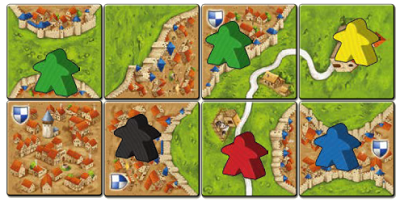
- Left city: Green is the only one to score 8 points (5 tiles and 3 coat of arms). Black does not score any points since Green has the most meeples in this city.
- Monastery: Yellow scores 4 points for this incomplete monastery (3 points for the adjacent tiles and 1 point for the monastery itself).
- Right city: Blue scores 3 points for this incomplete city (2 tiles and 1 coat of arms).
- Road: Red scores 3 points for this incomplete roads (3 tiles).
Once the final score is known, the winner is the player with the most points.[15]
Special cases
Viac spoločníkov na jednej ceste
Many meeples in the same city
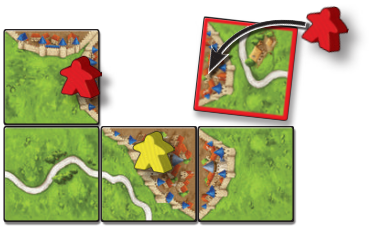
Use a meeple, score a feature, and get the meeple back
You can place a meeple in a feature you just completed, immediately score it, and then return the meeple to your supply.
To do so, follow these steps: [16]
__ 1. Place a tile, completing a feature (such as a road, city, or monastery).
__ 2. Place a meeple as a highwayman, knight, or monk on the feature you just completed.
__ 3. Score the completed road, city, or monastery and return the meeple to your supply.
![]() Otázka: There is a situation that puzzles us. If a player draws a tile with two city segments and completes a small city, earning 4 points, can he or she then deploy a meeple to a new city segment in the same turn?
Otázka: There is a situation that puzzles us. If a player draws a tile with two city segments and completes a small city, earning 4 points, can he or she then deploy a meeple to a new city segment in the same turn?
House rules
- The players decide who starts the game by any method they choose—such as by rolling three meeples. The first player to ‘roll’ a standing meeple decides who plays first. (Thanks to Joff.)
- To determine the first player; each player draws a tile from the bag, the player that drew the tile with the most roads (0 to 4) plays first, if there is a tie for most roads, a draw-off takes place. This is repeated until someone wins. (Thanks to michael.)
- Take your next tile at the end of your turn, to give you time to think about placement and avoid analysis paralysis.
- Play with a three-tile hand. The abbey counts as part of your hand. Play your turn, including the builder, and then draw back up to three tiles. These tiles could be visible to all or hidden to the other players (Thanks to DavidP and youtch.)
- When playing with a bag for the tiles, the original starting tile may be put into the bag, and unplayable tiles can be put back into the bag rather than set to one side. (Thanks to dwhitworth.)
- Trees (bushes) on roads do not end the road—only houses do (when the road forks). This makes road building a lot more dynamic. (Thanks to Tobias.)
- When a tile is the only tile which can currently complete a structure, other players can offer to ‘buy’ it by offering points, trades counter, abbey, and so on. (Thanks to Deatheux.)
- If you place a tile that fills a hole in the playing field by touching something on all four adjacent sides, you get another turn. This helps motivate people to finish the board even if they do not get an advantage from the placement. (Does not apply to the abbey tile). (Thanks to viberunner.)
- Incomplete features at the end of the game do not score points at the end of the game. (Thanks to metoth.)
- The edge of the table limits the playing area. Thus, a player may not place a tile past the edge of the table or move the playing area to place a tile that would have been past the edge of the table. (Thanks to metoth for prompting this one, and to SkullOne for pointing out that this is an official rule from Hunters and Gatherers.)
- Table borders COMPLETE features as an abbey would. (Thanks to PreGy.)
- Use colored dice instead of meeples on the scoring track. Start out with the 6 showing on top. When the marker completes one lap, turn it to the number 1 to indicate it has completed one lap. This shows at a glance which player is on what lap and who's ahead. On the 100 space track it’s even easier to determine someone’s score at a glance. (Thanks to Carcking.)
Use of a table
A number of questions have been asked about rules related to the play area itself, including what happens when the edge of the area is reached, or if a table has to be used for play. The following clarifications are from Georg Wild from HiG (5/2013):
- The edge of the table is the limit for the game if, as stated in the rules, a table is used.
- The rules state that the starting tile is placed in the middle of the table. If all of the tiles are shifted to allow more room, the starting tile would no longer be in the middle. So in principle, total shifting of the tiles is not allowed. Additionally, with a manual shift of all of the tiles, the tiles and figures on the field can slip, which could lead to incorrect positioning of tiles or figures.
- Addition of a second table is possible if one of an appropriate height is added to the first table. If a table is extended (as with an additional panel), make sure that the tiles and figures on the playing field do not slip.
- Playing on the floor: The rules technically do not allow this, because the rules state that the first tile is placed in the middle of the table. Playing on the floor is not forbidden, however, if use of a table is not feasible. If the floor is used, tiles must be placed so all tiles are visible to all players. Tiles cannot be placed under the sofa, cabinet/shelf, etc.
- It is important generally, that all the players in the round agree how to play:
- Table - Standard
- Table - with "total shifting" of tiles
- Table - with extension
- Floor
- Continue to play fairly and not intentionally unfair to other players.
Tile reference
Regular Base Game
Total Tiles: 72
One of the tiles marked with "(S)" -tile number four- is the starting tile (with a dark back).
Several tiles have a small illustration on them. The letters in brackets show which illustration is on each tile:
Note: The small illustrations of a cowshed, a pigsty and a donkey stable are collectively referred to as sheds or stables.
20th Anniversary Edition Base Game
Total Tiles: 72
One of the tiles marked with "(S)" -tile number four- is the starting tile (with a dark back).
Several tiles have a small illustration on them. The letters in brackets show which illustration is on each tile:
Note: The small illustrations of a cowshed, a pigsty and a donkey stable are collectively referred to as sheds or stables.
The 20th Anniversary Edition includes some celebratory details besides the glossy UV-printing:
- The highwaymen by the roads usually look a bit different, but they can also join the party (maybe they will be a bit more peaceful in the future...). In case you play with an expansion that use them, they will count as normal highwaymen, as usual.
- There are also additional details on the tiles, such as people partying everywhere, as well as hidden many so-called "Easter eggs". These make reference to other Carcassonne or HiG games. All these details have no effect on the rest of the game.
Carcassonne C3
Total Tiles: 72
One of the tiles marked with "(S)" -tile number four- is the starting tile (with a dark back).
Several tiles have a small illustration on them. The letters in brackets show which illustration is on each tile:
Note: The small illustrations of a cowshed, a pigsty and a donkey stable are collectively referred to as sheds or stables.
This edition replaces one pigsty for one cowshed in the tiles marked with *.
Footnotes
For Icons explanation and licensing please visit Icons page.
- ↑
 Dodatočné ilustráce na niektorých kartičkách nemajú žiadny vlplyv na základné pravidlá, ale môžu byť použité v niektorom z rozšírení, napr. Template:MarketLeipzigLink alebo
Dodatočné ilustráce na niektorých kartičkách nemajú žiadny vlplyv na základné pravidlá, ale môžu byť použité v niektorom z rozšírení, napr. Template:MarketLeipzigLink alebo  Mýtne.
Mýtne.
- ↑
 V pravidlách
V pravidlách  Big Box 6 a
Big Box 6 a  BigBox2021 sú spoločníci aj pre šieste hráča (v ružovej farbe) popísaný ako súčásť základnej hry a nie ako súčasť
BigBox2021 sú spoločníci aj pre šieste hráča (v ružovej farbe) popísaný ako súčásť základnej hry a nie ako súčasť  Hostince a katedrály, čím sa stávajú pravidlá prehľadnejšími.
Hostince a katedrály, čím sa stávajú pravidlá prehľadnejšími.
- ↑
 The ZMG rules of the base game mention the "first player" without explaining how it is decided. However, the Big Box 6 rules are re-aligned with the HiG rules and indicate the first player is the youngest one.
The ZMG rules of the base game mention the "first player" without explaining how it is decided. However, the Big Box 6 rules are re-aligned with the HiG rules and indicate the first player is the youngest one.
- ↑
 It is common practice to choose starting player at random. More on this in house rules section.
It is common practice to choose starting player at random. More on this in house rules section.
- ↑
 A newly placed land tile must fit the adjacent terrain on all edges! During placement it is not enough to look for only one side that fits.
A newly placed land tile must fit the adjacent terrain on all edges! During placement it is not enough to look for only one side that fits.
- ↑ 6.0 6.1
 Alternatively, if legal, the player could place the abbey tile (Exp. 5 - Abbey & Mayor) instead of drawing another tile. (1/2013)
Alternatively, if legal, the player could place the abbey tile (Exp. 5 - Abbey & Mayor) instead of drawing another tile. (1/2013)
 By extension, other tiles in the player's supply could be chosen: a German castle (Castles in Germany) or a Halfling tile (Halflings).
By extension, other tiles in the player's supply could be chosen: a German castle (Castles in Germany) or a Halfling tile (Halflings).
- ↑
 If drawing tiles out of a bag, a tile that cannot be placed could be returned to the bag for later use.
If drawing tiles out of a bag, a tile that cannot be placed could be returned to the bag for later use.
- ↑
 Village is a little set of red roofed buildings surrounding the crossroad.
Village is a little set of red roofed buildings surrounding the crossroad.
- ↑
 This list is valid in general terms and should be considered open ended. Some expansions incorporate additional features that may end a road, such as groups of trees and bushes, cottages, lakes, various types of ecclesiastical buildings, castles, etc.
This list is valid in general terms and should be considered open ended. Some expansions incorporate additional features that may end a road, such as groups of trees and bushes, cottages, lakes, various types of ecclesiastical buildings, castles, etc.
- ↑
 Note that a coat of arms only affects the city segment it is in, not the whole tile (if there is more than one segment on a single tile).
Note that a coat of arms only affects the city segment it is in, not the whole tile (if there is more than one segment on a single tile).
- ↑
 Kláštory môžu byť priložené veďla seba na susedných kartičkách. Nie je nutné, aby s kláštorem susedilo osem kartičiek, na ktorých se nenachádza kláštor. Na rozdiel od ciest, miest a lúk nieje možné sa pripojiť ku kláštoru.
Kláštory môžu byť priložené veďla seba na susedných kartičkách. Nie je nutné, aby s kláštorem susedilo osem kartičiek, na ktorých se nenachádza kláštor. Na rozdiel od ciest, miest a lúk nieje možné sa pripojiť ku kláštoru.
- ↑
 V niektorých rozšíreniach se môžete stretnúť s kartičkami kláštorov s okrajmi miest, a dokonce aj kláštory, ktoré sú vo vnútri miest.
V niektorých rozšíreniach se môžete stretnúť s kartičkami kláštorov s okrajmi miest, a dokonce aj kláštory, ktoré sú vo vnútri miest.
- ↑
 When two meeples of one color are occupying the same road, city, or field, you do not score double in these cases. The number of meeples (or in Exp. 1 - Inns and Cathedrals the size of the meeples) has no effect on the points that a player earns from a road, city, monastery, or field. Two knights do not double the points. The number of meeples is only important in establishing who has the majority.
When two meeples of one color are occupying the same road, city, or field, you do not score double in these cases. The number of meeples (or in Exp. 1 - Inns and Cathedrals the size of the meeples) has no effect on the points that a player earns from a road, city, monastery, or field. Two knights do not double the points. The number of meeples is only important in establishing who has the majority.
- ↑
 The ZMG rules state the following, which lead to certain interpretation issues when dealing with some expansions:
"The game ends immediately after the turn of the player who placed the last tile."
The ZMG rules state the following, which lead to certain interpretation issues when dealing with some expansions:
"The game ends immediately after the turn of the player who placed the last tile."
- ↑
 Rules do not include tiebreakers. That is rules explaining situation when few players share the same score.
Rules do not include tiebreakers. That is rules explaining situation when few players share the same score.
- ↑
 Note that features are considered to be complete as soon as the tile is placed, although meeple placement and scoring only occur afterwards. This is important when playing with magic portals (Exp. 3 - The Princess and the Dragon) or flying machines (Mini #1 - The Flier (Flying Machines)).
Note that features are considered to be complete as soon as the tile is placed, although meeple placement and scoring only occur afterwards. This is important when playing with magic portals (Exp. 3 - The Princess and the Dragon) or flying machines (Mini #1 - The Flier (Flying Machines)).
- Editor Manual - Old numbered parameters - FAQ
- Editor Manual - Old numbered parameters - RulesPlacingTile
- Editor Manual - Old numbered parameters - RulesPlacingMeeple
- Editor Manual - Old numbered parameters - RulesScoring
- Editor Manual - Old numbered parameters - Tile
- Old template
- Old template - FootnoteIconPara en
- Second Edition

